Environment settings
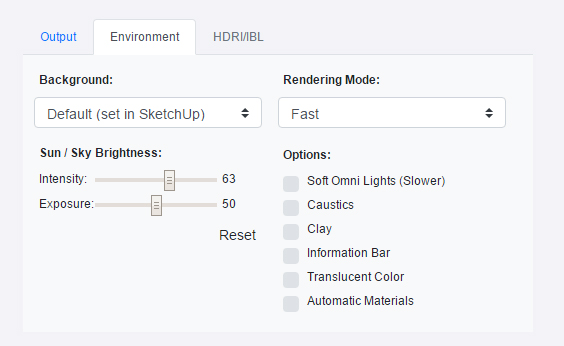
The Environment tab contains Podium's global settings for background, sky, lighting intensity, and several on/off checkboxes that control miscellaneous render settings.
This is also where HDR image-based lighting can be turned on.
Background settings - Default
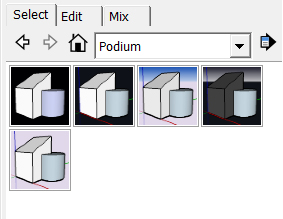
When 'Default' is selected, Podium will use your current SketchUp background color and/or SketchUp Sky settings (set in your SketchUp Style) for the background color of the rendered image. The default setting is a good way to render with a solid background color of your choosing.
Tip — There are five custom SketchUp styles in a Podium folder that can be used with the default background setting. Dark, Dark night, and Twilight are all suitable for rendering night scenes. With the .rbz install, you will need to install these Podium Styles manually. See here. Select 'Podium' from the styles drop-down to access these styles.
Background settings - Podium Physical Sky 1 & 2:
When 'Physical Sky 1 or 2' is selected, Podium calculates and displays sky turbidity (haziness caused by particles suspended in the atmosphere) and depth. Physical Sky will ignore the SketchUp background colors but rather is controlled by the preset variables, time day and year, location. Physical Sky will only be on when SketchUp Shadows are on.
The following video shows what the two physical skies look like with various date/time settings:
Video 04 in the Getting started series
SU Podium has two Physical Sky types.
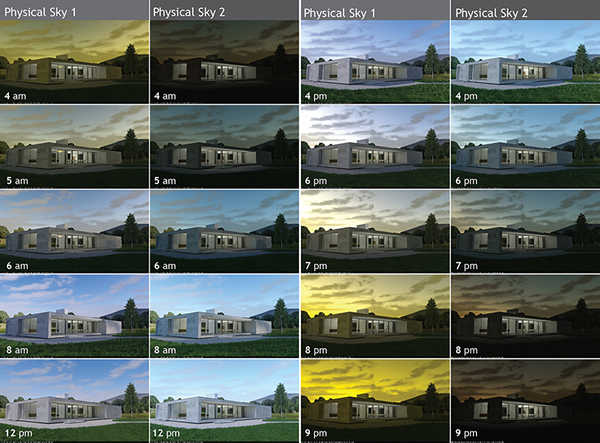
Podium's second physical sky option was designed to give users a more realistic representation of physical light levels seen toward the beginning and end of the day
About the chart: This chart illustrates the difference between Podium's two physical sky options, rendered using Exterior 1.07 preset at summer solstice, with default Intensity & Exposure values. All items, grass, treeline, and clouds, can be found in the Podium Browser.
- Podium Physical Sky 1: Podium's physical sky simulates a clear day using the date and time set in SketchUp. Physical Sky 1 improves upon the result given by SketchUp's default background, however this 1st version of the Podium sky often produces unwanted brightness and unnatural color shifts near dusk and dawn.
- Podium Physical Sky 2: The second version corrects those two issues by giving more realistic sunrises and sunsets, with no unwanted colors below the horizon. During daylight hours, Physical Sky 2 is slightly brighter with a more cyan tone than Physical Sky 1. For this reason, we kept the first physical sky, which remains a useful option for daytime renderings.
Physical Sky has a sky color gradient that you can not control. The color will depend on the time of the day and year that your SketchUp shadows are set to. If you don’t like this effect and/ or want to have control of the sky color as well as additional control of sun light, do the following:
SketchUp sky option:
There are situations that you do not want the physically accurate sky simulation. You may want to do a night rendering or need others atmospheres or you may find the physical sky is too bright and want to control background light with SketchUp colors.
- Tur<p class="mid-page-double lead"><strong>SketchUp sky option:</strong></p>n off Physical Sky in the SU Podium Options/Environment dialog.
- Go to SketchUp Styles and then to Background. Darken the color of your background. You can also turn off or on SketchUp's Sky.
- If your SketchUp Shadows are on, change the time of day of month so the sun is at a different angle.
SketchUp Styles: In some cases, you may want to turn off Physical Sky and use your own SketchUp styles. We have made some SketchUp styles to help you. These styles are simply modified SketchUp sky and background colors, and are described here.
Note: When your SketchUp shadows are on, Sun light is on regardless of what background option has been selected.
HDRI/IBL
HDR image-based lighting (IBL) is a new addition to the the SU Podium lighting workflow in SU Podium V2.6.0 and newer.
When HDR/IBL is activated, it becomes both the background of the render and the primary light source, replacing the SketchUp sun/shadow system and Podium Physical skies.
Please read more about it here.
Sun intensity and exposure sliders:
Sun intensity and exposure sliders in the Environment settings. Move sliders to the left to decrease intensity/exposure, and to the right to increase the intensity/exposure values. Reset will restore the values to the original state.
Video 03 in the Quick Start sequence
This video demonstrates how light levels change in the render when the intensity and exposure sliders are adjusted.
3. Options checkboxes:
Soft omni lights
This is a global setting for omni or point lights. The default setting is for this option to be checked off. However, if you want soft shadows to be applied to omni lights to create a natural lighting effect, turn this on. Soft Omni Lights is discussed in more detail in Light Section.
Caustics:
This will apply a caustic effect to transparent materials, globally.
Clay:
Clay is where textures are ignored and the entire model is rendered in the default, front face color of SketchUp - like a clay model.
Information Bar:
If this option is turned on, the rendered image will display an information bar at the bottom of the image. The information will contain the Podium version, rendering engine version number, preset used, time to render and the pixel size of the image. This is useful information to have when you contact Cadalog for support or share information on the Forum.
Translucent color::
SU Podium Version 2.x supports color in reflections of light passing through colored translucent material. This is most apparent in material that only has color but not textures. For example, the below example if of transparent material that only has colors. If these materials had texture images in them, the color reflection would not render.
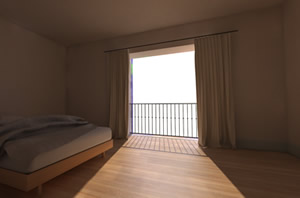
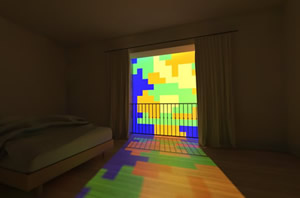
First image: Translucent color turned off; Second image: translucent color turned on.
Automatic materials:
SU Podium has a feature called Automatic Materials. When this is on (default), Podium will recognize SketchUp standard material names in your model and assign pre-defined, photo-realistic material properties to these specific SketchUp materials, automatically. This should reduce the amount of time you may spend setting up your model for photo-realistic renderings, IF you are using SketchUp standard materials. Automatic Materials will have no effect on imported textures/ materials. Please read or watch the video regarding Automatic Materials here.
